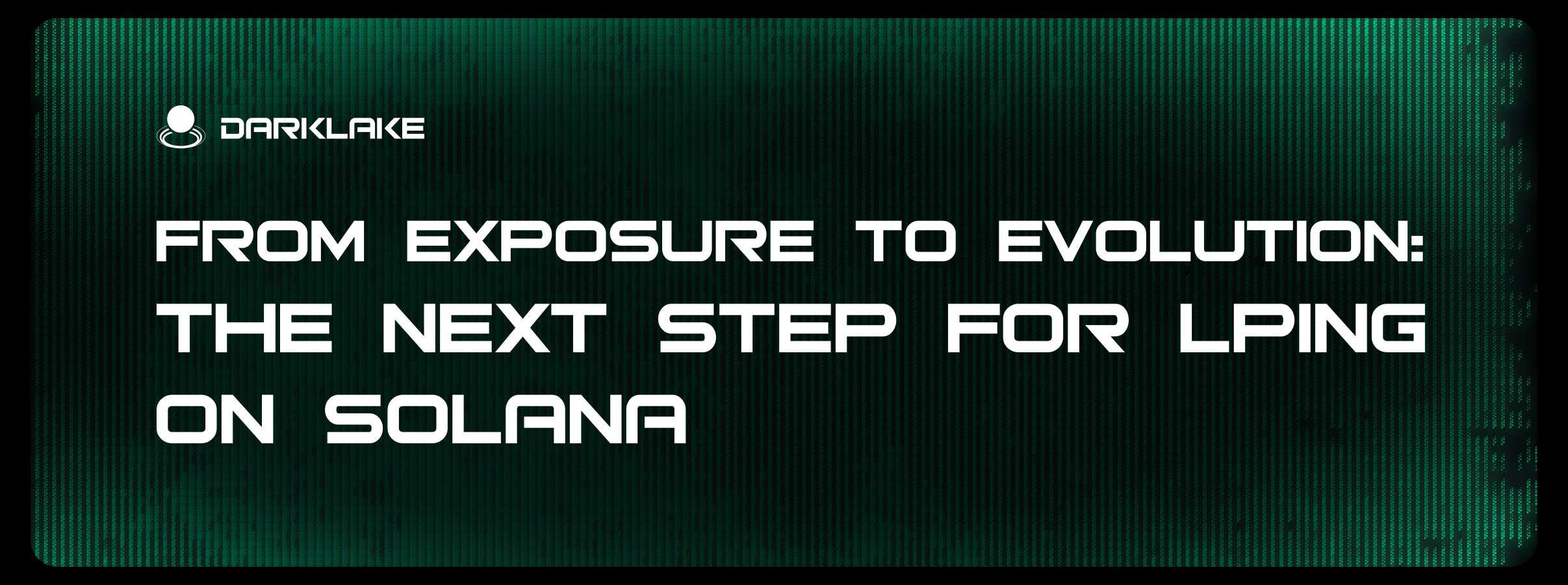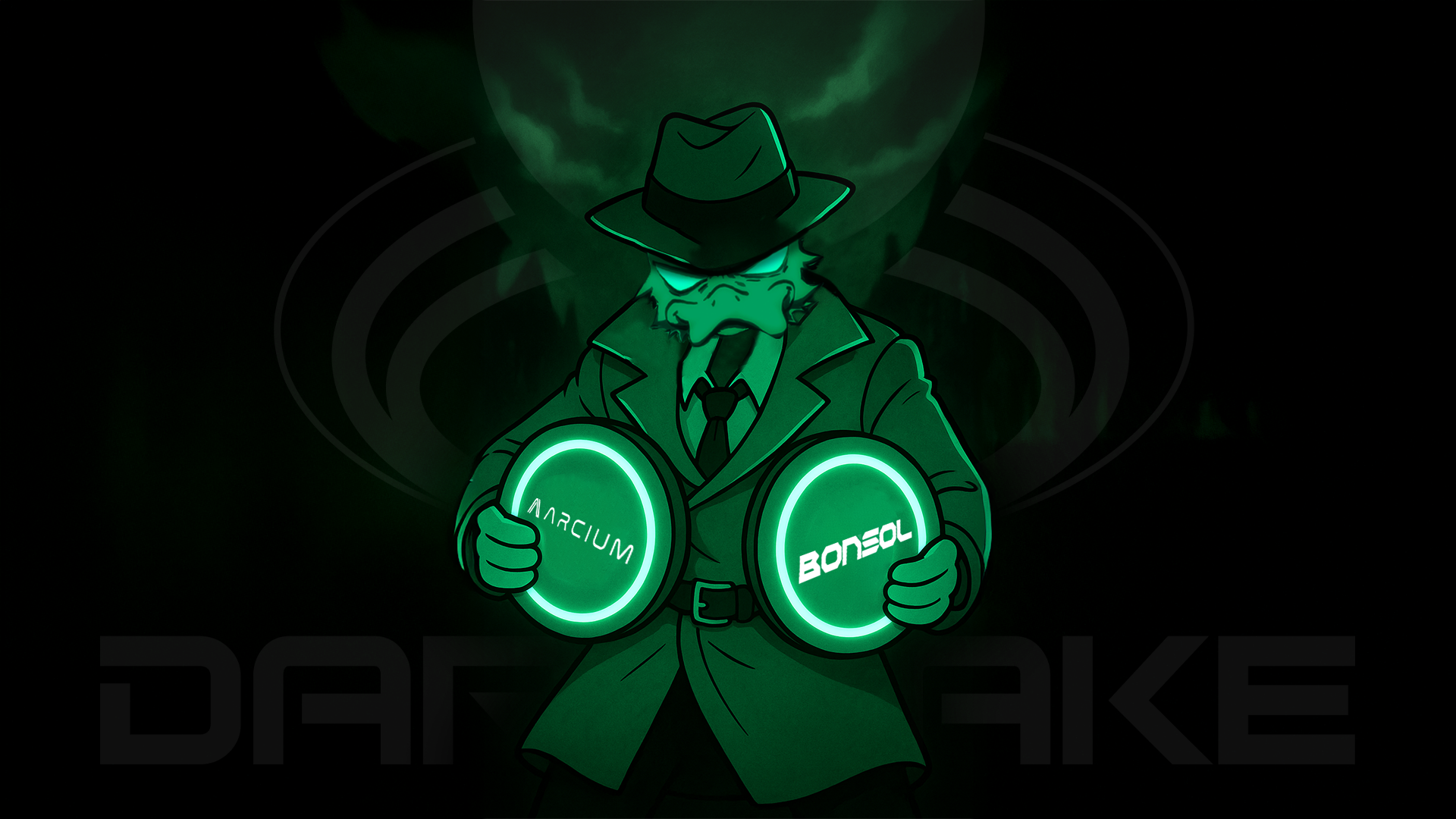
From Exposure to Evolution: The Next Step for LPing on Solana
Single-sided liquidity pools promised a simpler, smarter strading solution. One token in. No more impermanent loss. No more dual-asset juggling. On Solana, protocols like Orca, Raydium, Meteora, Jito, and BAM (Jito’s block-level privacy layer) introduced new mechanics. They pitched user-friendly yield, smarter capital efficiency, and fewer risks. However, they all share one structural limitation: visibility. Every LP position, including its range, intent, and exposure, is publicly observable. On-chain transparency allows sophisticated actors to monitor pool states, front-run pending trades, or time entries against known liquidity setups. This visibility does not only enable MEV. It quietly drains LP performance over time.
Darklake is the Next Step Forward
We are building customisable execution privacy. The goal is more than secrecy for its own sake. The goal is to give participants control over how and when their trading constraints become visible. LPs can choose to operate entirely in stealth or disclose selectively. Traders can settle without pre-trade exposure. Strategies remain private rather than becoming public invitations.
.png)
Orca brought concentrated liquidity via Whirlpools, allowing LPs to define narrow ranges. LPs can mimic single-sided setups for DCA or passive orders. All ranges are visible, which makes capital predictable and easy to target. Orca offers flexibility, but it does not provide discretion.
Raydium evolved from a constant-product AMM to a CLMM, enabling more precise liquidity provisioning. Transparency remains in place. LPs still broadcast ranges and depth, which is valuable intelligence for those who wish to trade against them.
Meteora introduced DLMM with price bins and volatility-based liquidity shaping. The system is expressive and powerful. Bin depth and distribution are still public. Sophisticated bin structures can become more attractive targets for frontrunners.
Jito secures transaction flow at the block level. This reduces sandwich attacks and bidding wars for priority fees. It is essential for fair sequencing, but it does not blind LP ranges or execution constraints.
BAM (Jito) uses secure enclaves to route orders privately. This works well in combination with Darklake. They hide the timing of execution, while we hide the parameters such as slippage targets and LP configurations. On its own, BAM does not protect those elements.
What Darklake Does Instead
Darklake introduces blind slippage pools to Solana. This is a user controlled security layer built around trader experience and LP protection:
- Customisable privacy modes allow users to choose full stealth or selective disclosures depending on strategy.
- Min-out hidden until settlement prevents bots from gaming slippage thresholds.
- ZK-proof gated execution proves fairness without revealing parameters.
- No pre-trade visibility removes the ability for bots to act on what they cannot see.
Whether you are a passive LP, an active rebalancer, or a high-frequency trader, your capital operates according to your rules rather than the network’s default exposure.
Blind Execution Meets Yield Retention
Every visible LP range is a free signal for MEV extraction. Bots see your liquidity, model your exposure, and harvest profit before you ever realize it. For LPs, you are giving others a direct tax payment on your yield.
Darklake eliminates that tax at the execution layer. Here’s how:
- When a trade hits your liquidity:
• If the taker’s minimum-out is satisfied, the trade clears instantly.
• If it is not satisfied, the trade auto-reverses with zero interim exposure, no half-filled orders, and no liquidity left dangling.
This structure delivers:
- Higher realized APY: LPs keep the spread they signed up for, without leaking edge to predatory flow.
- Reduced slippage for traders: Execution respects intent, not just visible depth.
- Zero MEV leakage: No exploitable windows, no unnecessary transfers, no hidden tax on yield.
Darklake builds the foundation of sustainable liquidty by protecting the agreement between LPs and takers.
Built for Solana Speed; Designed for Traders
Solana’s 400 millisecond slot time makes it ideal for zero-knowledge execution. Darklake integrates with existing AMM math and UX so strategies work as before, but execution parameters remain hidden until settlement.
Partnerships with Bonsol and Arcium make this possible:
- Bonsol provides distributed proving for near-instant ZK validation.
- Arcium delivers encrypted routing for privacy at the strategy level.
This is privacy as a configurable feature rather than an afterthought. It is built to be composable and part of the trader journey from the start.

Where Others Simulate Privacy, We Make It Configurable
If you are on Orca, Raydium, Meteora, Jito, or BAM alone, you are still operating in a visible liquidity environment. With Darklake:
- You decide how much of your LP strategy is visible.
- You define the timing of execution detail disclosures.
- You retain control over yield, slippage, and liquidity footprint.
Encrypted slippage. Private intent. Protected execution.
Darklake is not removing transparency. It is making transparency optional.
Deploy. Trade. On your terms.
featured blogs















🖥️ THE OBSERVATORY
A Machine. A Trail. A Warning.
You found it.
The hum of old circuits. The smell of scorched RAM and cheap takeout.
A terminal still running - untouched, but not abandoned.
I didn’t lock it. I left it open.
I’m Agent W.
Once a cog of the machine that enables the bleeding of wallets, now a MEV hunter that is preventing extraction.
I used to believe in the protocol. In fairness. In the idea that traders were safe, that transactions were airtight.
Then they took my stake.
2,187,433 SOL. Seized under a governance vote while I was offline.
They forgot who I am.
📂 What you’ll find
This isn’t your average website.
This is my journal. If you are here, it isn’t by accident. It’s because I wanted you to read it.
The devlogs I’ve developed, the blogs and whitepapers - all left behind to pass my learnings on to you and teach you how to shield yourself from the danger that lurks in the dark.
🔎 Why I’m doing this
Extraction cuts deep into someone’s finances. Take this report, for example:
🧾 March 2025
➜ 81.0 SOL traded
➜ 44.82 SOL extracted
That’s 55% of the total. It’s not a bit of risk - it’s more than half of what the trader had, now gone.
🕶️ Rules of the Machine
- Click what you see.
- Filter the pages you want to see by using the boxes in the right corner
- If a folder's glowing? It's glowing for a reason.
- If something makes no sense? You’re getting close.
☠️ Final Warning
Once you start reading these blogs, you won’t see Solana the same way.
You’ll start noticing the shadows between blocks. The extractions that reach higher and higher amounts. The LPs getting less and less returns. The bots that never sleep. Front-runs disguised as fair trades. Mempools that are nothing but pens for cattle - corralling the cattle for the wolves to eat.
You’ll begin to understand that this isn’t a bug. It’s a battle in the name of fair markets.
The chain never forgets.
Neither do I.
Now, neither do you.
— Agent W
🥃💾
.png)























Personal PC


















Maybe it's not a good idea to shut my website down without a hardware reset button. Proceed?



Just kidding. Nothing was actually shutdown. It wouldn't have been a good idea. Do it again?



Permission denied. Please reconsider your actions.
.png)